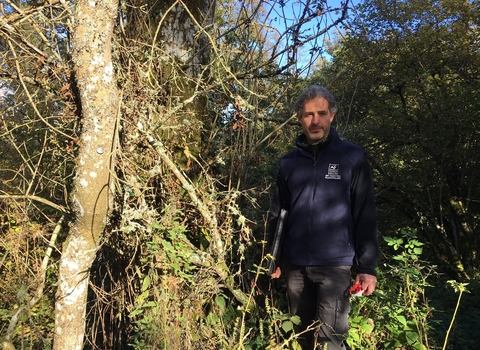The symptoms of ash dieback, caused by the fungus Hymenoscyphus fraxineus, are most noticeable between June and September when the trees’ leaves are fully out. We have again been busy during this period, repeating surveys to find out how the disease is developing. Having seen rapid decline in tree health across many of the reserves from summer 2018 to summer 2019, sadly a similar picture has emerged for 2019 to 2020. It is possible that climatic conditions – the dry spring and wet summer – have contributed firstly by putting trees under stress and then by providing ideal conditions for fungal spores to spread. The impact remains uneven, both between and within reserves, and we are still hopeful that some long-term resistance will eventually emerge.
In order to give resistant trees a chance to reproduce, we aim to retain as many infected ash as possible, for as long as possible. Those that die will also be retained wherever possible: many rare and important species of invertebrates and fungi rely on decaying wood, with standing dead trees a particularly valuable habitat. Therefore, before considering felling, we will always look for ways to prevent people from coming near to dangerous trees, for example by moving or closing paths. In many cases, this isn’t possible; where dangerous trees are close to roads and buildings, we are obliged to fell or prune them to make them safe.
Following our surveys this summer, we have been forced to make some particularly difficult decisions about tree works and public access at Bailey Einon, Llanbwchllyn, Withybeds and Gilfach.
Bailey Einon
There are up to thirty-five ash trees with severe dieback and the potential to fall onto the path. The cost of tree surgery and felling to make them safe would be high and the removal of these trees would have a severe and sudden impact on the ecology of the woodland. Ash is the most frequent canopy tree and some of the largest and oldest trees in the wood are next to the path and would have to be felled to keep it open safely. A very large quantity of brash and logs would be generated and a lack of access for machinery would make extraction impractical, resulting in some smothering of the spring flora.
Despite the footpath forming part of several local walks, we estimate that an alternative route passing above the reserve would add around 400 metres to a journey. We have, therefore, decided to close the path and the reserve in the near future. Being close to Llandrindod and the popular Shaky Bridge area, the reserve is moderately well visited and we know that closure will be an inconvenience. It is likely to be some years before the trees die and fall naturally, so we are unable to say when the path will re-open.
Llanbwchllyn
Like Bailey Einon, the canopy of the ancient woodland area at Llanbwchllyn is predominately made up of ash, with the path to the hide lined by some especially fine old specimens. In general, the trees here are less badly affected than at Bailey Einon, and there is no significant risk to path users at this stage. Unfortunately, a very large ash next to the bird hide is in the advanced phases of dieback and poses a risk to visitors. We have decided to retain this tree which means that the hide, currently closed due to Covid-19, will remain closed for the foreseeable future. Although overall visitor numbers are small, the hide is regularly used during the winter months. We will seek funding opportunities to move the hide or construct a new one in a safer location as soon as possible.
Withybeds
The floodplain woodland at Withybeds on the edge of Presteigne, though dominated by willow and alder, has a number of mature and veteran ash trees, mainly lining the old mill leat. Ash dieback has quickly taken hold in many of these trees during the last 12 months and we will need to carry out substantial works over the coming winter in order to keep the well-used paths open. We will retain as much standing deadwood as possible, reducing trees to a height such that they would not reach the path if they fell. Any path closure during the works will be of very limited duration, but there will be a significant visual and ecological impact.
Gilfach
Ten ash trees at Gilfach will be felled or pruned. The most significant is a large old tree below the longhouse, near the drive and picnic area. In this very well used part of the reserve there is little other option than to fell the tree.

